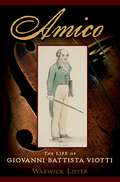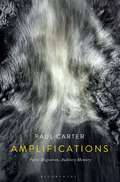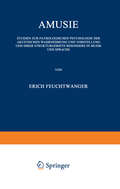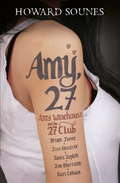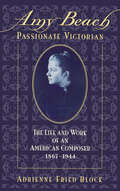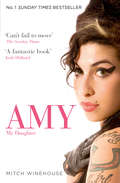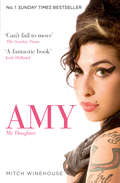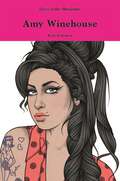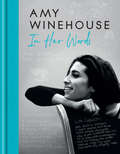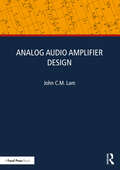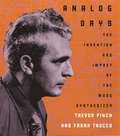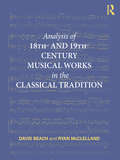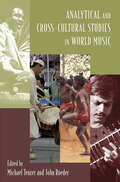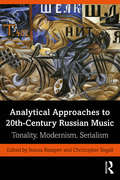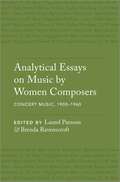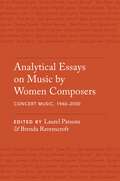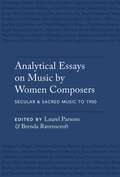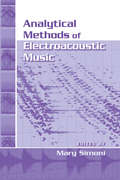- Table View
- List View
Amico: The Life of Giovanni Battista Viotti
by Warwick ListerThis is the first full-length biography in English of Giovanni Battista Viotti (1755-1824), one of the great violinist-composers in the history of music, and arguably the most influential violinist who ever lived. This study is based on extensive documentary research, much of it here revealed for the first time.
Amplifications: Poetic Migration, Auditory Memory (PDF)
by Paul CarterWritten by one of the most prominent thinkers in sound studies, Amplifications presents a perspective on sound narrated through the experiences of a sound artist and writer. A work of reflective philosophy, Amplifications sits at the intersection of history, creative practice, and sound studies, recounting this narrative through a series of themes (rattles, echoes, recordings, etc.). Carter offers a unique perspective on migratory poetics, bringing together his own compositions and life's works while using his personal narrative to frame larger theoretical questions about sound and migration.
Amplifications (PDF): Poetic Migration, Auditory Memory
by Paul CarterWritten by one of the most prominent thinkers in sound studies, Amplifications presents a perspective on sound narrated through the experiences of a sound artist and writer. A work of reflective philosophy, Amplifications sits at the intersection of history, creative practice, and sound studies, recounting this narrative through a series of themes (rattles, echoes, recordings, etc.). Carter offers a unique perspective on migratory poetics, bringing together his own compositions and life's works while using his personal narrative to frame larger theoretical questions about sound and migration.
Amusie: Studien zur Pathologischen Psychologie der Akustischen Wahrnehmung und Vorstellung und Ihrer Strukturgebiete Besonders in Musik und Sprache (Handbuch der Neurologie #57)
by Erich FeuchtwangerDieser Buchtitel ist Teil des Digitalisierungsprojekts Springer Book Archives mit Publikationen, die seit den Anfängen des Verlags von 1842 erschienen sind. Der Verlag stellt mit diesem Archiv Quellen für die historische wie auch die disziplingeschichtliche Forschung zur Verfügung, die jeweils im historischen Kontext betrachtet werden müssen. Dieser Titel erschien in der Zeit vor 1945 und wird daher in seiner zeittypischen politisch-ideologischen Ausrichtung vom Verlag nicht beworben.
Amy, 27: Amy Winehouse And The 27 Club
by Howard SounesThe death of Amy Winehouse at the age of 27 was a tragedy.She was one of the brightest music stars in years -a brilliant, original song writer with a mighty voice and great personal charm. Amy was loveable, but troubled. She was as notorious for her messy personal life, drug addiction and alcoholism, as she was celebrated for her songs, and her death in 2011, while shocking, was not unexpected.Amy was also the latest in a series of iconic music stars who died at the same young age; starting with Brian Jones of the Rolling Stones whose death in 1969 was followed by Jimi Hendrix and Janis Joplin in 1970, Jim Morrison in 1971, and Kurt Cobain in 1994. All were gifted. All were dissipated. All were 27.The 27 Club was first used as a collective term for these lost souls after a comment by Kurt Cobain's mother. 'He's gone and joined that stupid club,' she said after Kurt shot himself. 'I told him not to ...'In this ground-breaking book, Howard Sounes delivers a detailed and insightful study of Amy Winehouse's life, and sets that life in the context of the 27 Club. That six big music stars died at 27 -- along with 44 less well-known names -- is on one level a coincidence. But behind this coincidence Sounes reveals is a disturbing common narrative that explains how these artists met their fate, and casts new light on Amy's death in particular.
Amy Beach, Passionate Victorian: The Life and Work of an American Composer, 1867-1944
by Adrienne Fried BlockAmy Marcy Cheney Beach (1867-1944), the most widely performed composer of her generation, was the first American woman to succeed as a creator of large-scale art music. Her "Gaelic" Symphony, given its premiere by the Boston Symphony Orchestra in 1896, was the first work of its kind by an American woman to be performed by an American orchestra. Almost all of her more than 300 works were published soon after they were composed and performed, and today her music is finding new advocates and audiences for its energy, intensity, and sheer beauty. Yet, until now, no full-length critical biography of Beach's life or comprehensive critical overview of her music existed. This biography admirably fills that gap, fully examining the connections between Beach's life and work in light of social currents and dominant ideologies. Born into a musical family in Victorian times, Amy Beach started composing as a child of four and was equally gifted as a pianist. Her talent was recognized early by Boston's leading musicians, who gave her unqualified support. Although Beach believed that the life of a professional musician was the only life for her, her parents had raised her for marriage and a career of amateur music-making. Her response to this parental (and later spousal) opposition was to find creative ways of reaching her goal without direct confrontation. Discouraged from a full-scale concert career, she instead found her métier in composition. Success as a composer of art songs came early for Beach: indeed, her songs outsold those of her contemporaries. Nevertheless, she was determined to separate her work from the genteel parlor music women were writing in her day by creating large-scale works--a Mass, a symphony, and chamber music--that challenged the accepted notion that women were incapable of creating high art. She won the respect of colleagues and the allegiance of audiences. Many who praised her work, however, considered her an exception among women. Beach's reaction to this was to join with other women composers of serious music by promoting their works along with her own. Adrienne Fried Block has written a biography that takes full account of issues of gender and musical modernism, considering Beach in the contexts of her time and of her composer contemporaries, both male and female. Amy Beach, Passionate Victorian will be of great interest to students and scholars of American music, and to music lovers in general.
Amy, My Daughter
by Mitch WinehouseNo. 1 Sunday Times Bestseller. ‘Can’t fail to move’ The Sunday Times ALL AUTHOR PROCEEDS DONATED TO THE AMY WINEHOUSE FOUNDATION.
Amy Winehouse (Lives of the Musicians)
by Kate SolomonIn her intense, brief life, Amy Winehouse's music spoke directly to millions. And since her death, her fans have only increased.Amy Winehouse is one of those pop stars that comes along so rarely we're not sure we knew what we had when we had her. Her story speaks to us not because the relentless tabloid coverage of her darker days unfolded in real time, but because she tapped into deeply personal yet universal feelings and displayed them to us in all their painful, raw glory. She turned our demons into something we could dance and sing to, and she skewered those who wronged her in ways we could only dream of.
Amy Winehouse – In Her Words
by Amy WinehouseGlobal icon Six-time Grammy winner Headline-maker The most talented recording artist of her generation
Analog Audio Amplifier Design
by John C.M. LamAnalog Audio Amplifier Design introduces all the fundamental principles of analog audio amplifiers, alongside practical circuit design techniques and advanced topics. Covering all the basics of amplifier operation and configuration, as well as high-end audio amplifiers, this is a comprehensive guide with design examples and exercises throughout. With chapters on single-device, operational, multi-stage, voltage buffer, power, line-stage and phono-stage amplifiers, Analog Audio Amplifier Design is a comprehensive and practical introduction that empowers readers to master a range of design techniques. This book also provides a variety of graphs and tables of key amplifying devices and properties of amplifier configurations for easy reference. This is an essential resource for audio professionals and hobbyists interested in audio electronics and audio engineering, as well as students on electrical and audio engineering courses.
Analog Audio Amplifier Design
by John C.M. LamAnalog Audio Amplifier Design introduces all the fundamental principles of analog audio amplifiers, alongside practical circuit design techniques and advanced topics. Covering all the basics of amplifier operation and configuration, as well as high-end audio amplifiers, this is a comprehensive guide with design examples and exercises throughout. With chapters on single-device, operational, multi-stage, voltage buffer, power, line-stage and phono-stage amplifiers, Analog Audio Amplifier Design is a comprehensive and practical introduction that empowers readers to master a range of design techniques. This book also provides a variety of graphs and tables of key amplifying devices and properties of amplifier configurations for easy reference. This is an essential resource for audio professionals and hobbyists interested in audio electronics and audio engineering, as well as students on electrical and audio engineering courses.
Analog Days: The Invention and Impact of the Moog Synthesizer
by Trevor Pinch Frank TroccoThough ubiquitous today, available as a single microchip and found in any electronic device requiring sound, the synthesizer when it first appeared was truly revolutionary. Something radically new--an extraordinary rarity in musical culture--it was an instrument that used a genuinely new source of sound: electronics. How this came to be--how an engineering student at Cornell and an avant-garde musician working out of a storefront in California set this revolution in motion--is the story told for the first time in Analog Days, a book that explores the invention of the synthesizer and its impact on popular culture. The authors take us back to the heady days of the 1960s and early 1970s, when the technology was analog, the synthesizer was an experimental instrument, and synthesizer concerts could and did turn into happenings. Interviews with the pioneers who determined what the synthesizer would be and how it would be used--from inventors Robert Moog and Don Buchla to musicians like Brian Eno, Pete Townshend, and Keith Emerson--recapture their visions of the future of electronic music and a new world of sound. Tracing the development of the Moog synthesizer from its initial conception to its ascension to stardom in Switched-On Bach, from its contribution to the San Francisco psychedelic sound, to its wholesale adoption by the worlds of film and advertising, Analog Days conveys the excitement, uncertainties, and unexpected consequences of a new technology that would provide the soundtrack for a critical chapter of our cultural history.
Analysis of 18th- and 19th-Century Musical Works in the Classical Tradition
by David Beach Ryan McClellandAnalysis of 18th- and 19th-Century Musical Works in the Classical Tradition is a textbook for upper-level undergraduate and graduate courses in music analysis. It outlines a process of analyzing works in the Classical tradition by uncovering the construction of a piece of music—the formal, harmonic, rhythmic, and voice-leading organizations—as well as its unique features. It develops an in-depth approach that is applied to works by composers including Haydn, Mozart, Beethoven, Schubert, Schumann, and Brahms. The book begins with foundational chapters in music theory, starting with basic diatonic harmony and progressing rapidly to more advanced topics, such as phrase design, phrase expansion, and chromatic harmony. The second part contains analyses of complete musical works and movements. The text features over 150 musical examples, including numerous complete annotated scores. Suggested assignments at the end of each chapter guide students in their own musical analysis.
Analysis of 18th- and 19th-Century Musical Works in the Classical Tradition
by David Beach Ryan McClellandAnalysis of 18th- and 19th-Century Musical Works in the Classical Tradition is a textbook for upper-level undergraduate and graduate courses in music analysis. It outlines a process of analyzing works in the Classical tradition by uncovering the construction of a piece of music—the formal, harmonic, rhythmic, and voice-leading organizations—as well as its unique features. It develops an in-depth approach that is applied to works by composers including Haydn, Mozart, Beethoven, Schubert, Schumann, and Brahms. The book begins with foundational chapters in music theory, starting with basic diatonic harmony and progressing rapidly to more advanced topics, such as phrase design, phrase expansion, and chromatic harmony. The second part contains analyses of complete musical works and movements. The text features over 150 musical examples, including numerous complete annotated scores. Suggested assignments at the end of each chapter guide students in their own musical analysis.
Analysis, Synthesis, and Perception of Musical Sounds: The Sound of Music (Modern Acoustics and Signal Processing)
by James BeauchampThis book contains a complete and accurate mathematical treatment of the sounds of music with an emphasis on musical timbre. The book spans the range from tutorial introduction to advanced research and application to speculative assessment of its various techniques. All the contributors use a generalized additive sine wave model for describing musical timbre which gives a conceptual unity, but is of sufficient utility to be adapted to many different tasks.
Analytical and Cross-Cultural Studies in World Music
by Michael Tenzer John RoederThis collection presents intriguing explanations of extraordinary musical creations from across the world, concentrating on how the music works as sound in process. It suggests analytical approaches that apply across cultures, proposes a new way of classifying music, and treats provocative questions about the juxtaposition of music from different cultures.
Analytical Approaches to 20th-Century Russian Music: Tonality, Modernism, Serialism
by Inessa Bazayev Christopher SegallThis volume brings together analyses of works by thirteen Russian composers from across the twentieth century, showing how their approaches to tonality, modernism, and serialism forge forward-looking paths independent from their Western counterparts. Russian music of this era is widely performed, and much research has situated this repertoire in its historical and social context, yet few analytical studies have explored the technical aspects of these composers' styles. With a set of representative analyses by leading scholars in music theory and analysis, this book for the first time identifies large-scale compositional trends in Russian music since 1900. The chapters progress by compositional style through the century, and each addresses a single work by a different composer, covering pieces by Rachmaninoff, Myaskovsky, Prokofiev, Shostakovich, Mansurian, Roslavets, Mosolov, Lourié, Tcherepnin, Ustvolskaya, Denisov, Gubaidulina, and Schnittke. Musicians, scholars, and students will find here a starting point for research and analysis of these composers' works and gain a richer understanding of how to listen to and interpret their music.
Analytical Essays on Music by Women Composers: Concert Music, 19001960
by Laurel Parsons, Brenda RavenscroftThrough musical analysis of compositions written in the first half of the twentieth century, Analytic Essays on Music by Women Composers: Concert Music, 1900-1960 celebrates the achievements of eight composers: Alma Mahler-Werfel (1879-1964), Rebecca Clarke (1886-1979), Dame Ethel Smyth (1858-1944), Ruth Crawford (1901-53), Florence B. Price (1887-1953), Galina Ustvolskaya (1919-2006), J. M. Beyer (1888-1944), and Peggy Glanville-Hicks (1912-90). Written by outstanding music theorists and musicologists, the essays provide thought-provoking in-depth explorations of representative compositions, often linking analytical observations with questions of meaning and sociohistorical context. Each essay is introduced by a brief biographical sketch of the composer by editors Laurel Parsons and Brenda Ravenscroft. This collection - Volume 2 in an unprecedented four-volume series of analytical studies on music by women composers - is designed to challenge and stimulate a wide range of readers. For academics, these thoughtful analytical essays can open new paths into unexplored research areas in the fields of music theory and musicology. Post-secondary instructors may be inspired by the insights offered in these essays to include new works in music theory and history courses at both graduate and upper-level undergraduate levels, or in courses on women and music. Finally, for soloists, ensembles, conductors, and music broadcasters, these detailed analyses can offer enriched understandings of this repertoire and suggest fresh, new programming possibilities to share with listeners.
Analytical Essays on Music by Women Composers: Concert Music, 19001960
Through musical analysis of compositions written in the first half of the twentieth century, Analytic Essays on Music by Women Composers: Concert Music, 1900-1960 celebrates the achievements of eight composers: Alma Mahler-Werfel (1879-1964), Rebecca Clarke (1886-1979), Dame Ethel Smyth (1858-1944), Ruth Crawford (1901-53), Florence B. Price (1887-1953), Galina Ustvolskaya (1919-2006), J. M. Beyer (1888-1944), and Peggy Glanville-Hicks (1912-90). Written by outstanding music theorists and musicologists, the essays provide thought-provoking in-depth explorations of representative compositions, often linking analytical observations with questions of meaning and sociohistorical context. Each essay is introduced by a brief biographical sketch of the composer by editors Laurel Parsons and Brenda Ravenscroft. This collection - Volume 2 in an unprecedented four-volume series of analytical studies on music by women composers - is designed to challenge and stimulate a wide range of readers. For academics, these thoughtful analytical essays can open new paths into unexplored research areas in the fields of music theory and musicology. Post-secondary instructors may be inspired by the insights offered in these essays to include new works in music theory and history courses at both graduate and upper-level undergraduate levels, or in courses on women and music. Finally, for soloists, ensembles, conductors, and music broadcasters, these detailed analyses can offer enriched understandings of this repertoire and suggest fresh, new programming possibilities to share with listeners.
Analytical Essays on Music by Women Composers: Concert Music, 1960-2000
by Laurel Parsons and Brenda RavenscroftOver the past 30 years, musicologists have produced a remarkable new body of research literature focusing on the lives and careers of women composers in their socio-historical contexts. But detailed analysis and discussion of the works created by these composers are still extremely rare. This is particularly true in the domain of music theory, where scholarly work continues to focus almost exclusively on male composers. Moreover, while the number of performances, broadcasts, and recordings of music by women has unquestionably grown, these works remain significantly underrepresented in comparison to music by male composers. Addressing these deficits is not simply a matter of rectifying a scholarly gender imbalance: the lack of knowledge surrounding the music of female composers means that scholars, performers, and the general public remain unfamiliar with a large body of exciting repertoire. Analytical Essays on Music by Women Composers: Concert Music, 1960-2000 is the first to appear in a groundbreaking four-volume series devoted to compositions by women across Western art music history. Each chapter opens with a brief biographical sketch of the composer before presenting an in-depth critical-analytic exploration of a single representative composition, linking analytical observations with questions of meaning and sociohistorical context. Chapters are grouped thematically by analytical approach into three sections, each of which places the analytical methods used in the essays that follow into the context of late twentieth-century ideas and trends. Featuring rich analyses and critical discussions, many by leading music theorists in the field, this collection brings to the fore repertoire from a range of important composers, thereby enabling further exploration by scholars, teachers, performers, and listeners.
Analytical Essays on Music by Women Composers: Concert Music, 1960-2000
by Laurel Parsons Brenda RavenscroftOver the past 30 years, musicologists have produced a remarkable new body of research literature focusing on the lives and careers of women composers in their socio-historical contexts. But detailed analysis and discussion of the works created by these composers are still extremely rare. This is particularly true in the domain of music theory, where scholarly work continues to focus almost exclusively on male composers. Moreover, while the number of performances, broadcasts, and recordings of music by women has unquestionably grown, these works remain significantly underrepresented in comparison to music by male composers. Addressing these deficits is not simply a matter of rectifying a scholarly gender imbalance: the lack of knowledge surrounding the music of female composers means that scholars, performers, and the general public remain unfamiliar with a large body of exciting repertoire. Analytical Essays on Music by Women Composers: Concert Music, 1960-2000 is the first to appear in a groundbreaking four-volume series devoted to compositions by women across Western art music history. Each chapter opens with a brief biographical sketch of the composer before presenting an in-depth critical-analytic exploration of a single representative composition, linking analytical observations with questions of meaning and sociohistorical context. Chapters are grouped thematically by analytical approach into three sections, each of which places the analytical methods used in the essays that follow into the context of late twentieth-century ideas and trends. Featuring rich analyses and critical discussions, many by leading music theorists in the field, this collection brings to the fore repertoire from a range of important composers, thereby enabling further exploration by scholars, teachers, performers, and listeners.
Analytical Essays on Music by Women Composers: Secular & Sacred Music to 1900
by Laurel Parsons and Brenda RavenscroftThrough musical analysis of compositions written between the mid-twelfth to late nineteenth centuries, this volume celebrates the achievements of eight composers, all women: Hildegard of Bingen, Maddalena Casulana, Barbara Strozzi, Élisabeth Jacquet de la Guerre, Marianne Martines, Josephine Lang, Fanny Hensel, Clara Schumann, and Amy Beach. Written by outstanding music theorists and musicologists, the essays provide fascinating in-depth critical-analytic explorations of representative compositions, often linking analytical observations with questions of meaning and sociohistorical context. Each essay is introduced by a brief biographical sketch of the composer by the editors. The collection--Volume 1 in an unprecedented four-volume series of analytical studies on music by women composers--is designed to challenge and stimulate a wide range of readers. For academics, these thoughtful analytical essays can open new paths into unexplored research areas in the fields of music theory and musicology. Post-secondary instructors may be inspired by the insights offered in these essays to include new works in music theory and history courses at both graduate and upper-level undergraduate levels, or in courses on women and music. Finally, for soloists, ensembles, conductors, and music broadcasters, these detailed analyses can offer enriched understandings of this repertoire and suggest fresh, new programming possibilities to share with listeners.
Analytical Essays on Music by Women Composers: Secular & Sacred Music to 1900
Through musical analysis of compositions written between the mid-twelfth to late nineteenth centuries, this volume celebrates the achievements of eight composers, all women: Hildegard of Bingen, Maddalena Casulana, Barbara Strozzi, Élisabeth Jacquet de la Guerre, Marianne Martines, Josephine Lang, Fanny Hensel, Clara Schumann, and Amy Beach. Written by outstanding music theorists and musicologists, the essays provide fascinating in-depth critical-analytic explorations of representative compositions, often linking analytical observations with questions of meaning and sociohistorical context. Each essay is introduced by a brief biographical sketch of the composer by the editors. The collection--Volume 1 in an unprecedented four-volume series of analytical studies on music by women composers--is designed to challenge and stimulate a wide range of readers. For academics, these thoughtful analytical essays can open new paths into unexplored research areas in the fields of music theory and musicology. Post-secondary instructors may be inspired by the insights offered in these essays to include new works in music theory and history courses at both graduate and upper-level undergraduate levels, or in courses on women and music. Finally, for soloists, ensembles, conductors, and music broadcasters, these detailed analyses can offer enriched understandings of this repertoire and suggest fresh, new programming possibilities to share with listeners.
Analytical Methods of Electroacoustic Music
by Mary SimoniContaining extensive artwork serving as demonstration, as well as a DVD with sound and video clips, this collection of essays on electroacoustic music explores the creative possibilities to be found in various forms of musical analysis. Taking pitch, duration, intensity, and timbre as the four basic elements of music, the authors discuss electroacoustic works and examine: * the applications of neumes* contemporary staff notation* sound orchestra and score files* time-domain representations* spectrograms. Taking into consideration both the positive aspects (preservation of the abstract) and negative aspects (creative limitation) of these analytical methods, the authors have created a useful resource for students of electroacoustic music.
